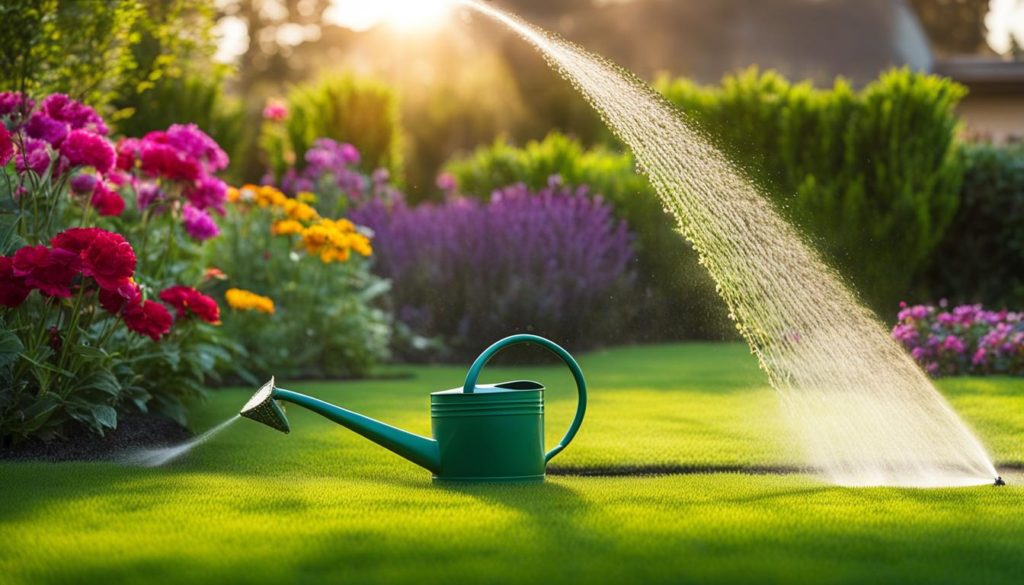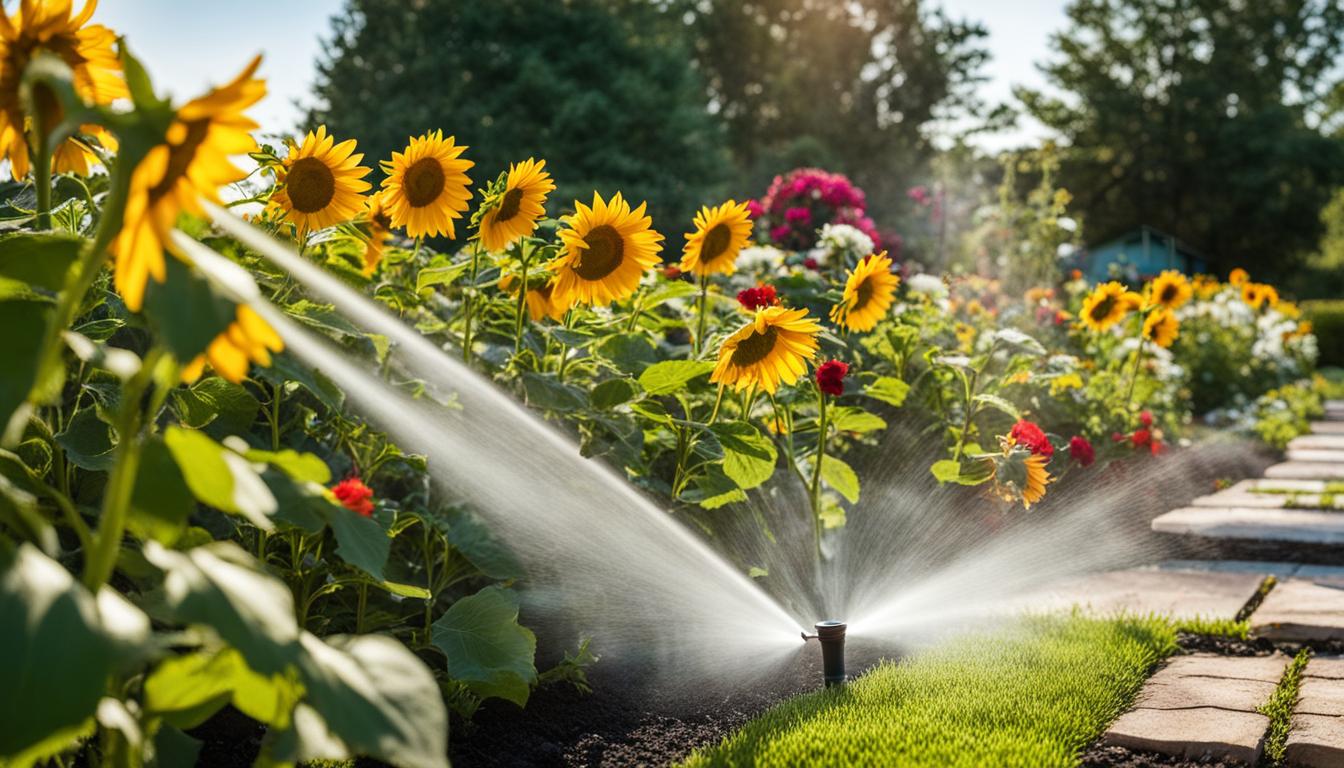Watering your flower beds is a crucial aspect of maintaining a healthy and vibrant garden. However, finding the right watering routine can be a bit challenging. There is no one-size-fits-all approach as it depends on various factors such as the local climate, weather conditions, shade, and the specific needs of your plants.
Before diving into the guidelines for watering your flower beds, it’s important to understand the moisture and soil preferences of each plant in your garden. Some flowers are more drought-tolerant and require less water, while others thrive in moist soil. By understanding the specific needs of your plants, you can create an effective watering schedule.
When it comes to watering flower beds, it’s recommended to aim for 1 inch of water once per week or around 1/2 inch of water twice weekly. This allows the water to penetrate deep into the soil and reach the roots. However, container plants, hanging baskets, and raised beds may require more frequent watering.
Young plants and freshly planted flowers need extra care and attention, so they should be watered daily until their root systems establish. It’s important to water your garden in the morning or evening, avoiding the midday heat. This helps to keep the leaves dry and prevent diseases. Watering at soil level ensures that the water reaches the roots effectively.
Remember, finding the right balance is key. Overwatering can be harmful to plants, so it’s essential to monitor the moisture levels and adjust your watering schedule accordingly.
Key Takeaways:
- Consider factors such as climate, weather conditions, shade, and plant needs when determining the watering frequency for your flower beds.
- Understand the moisture and soil preferences of each plant in your garden to create an effective watering schedule.
- Aim for 1 inch of water once per week or around 1/2 inch of water twice weekly for flower beds, adjusting as needed for container plants, hanging baskets, and raised beds.
- Young plants and freshly planted flowers require more frequent watering until their root systems establish.
- Water your garden in the morning or evening, avoiding midday heat, and make sure to water at soil level to reach the roots effectively.
Understanding Your Climate and Plant Water Needs
When it comes to watering your flower beds, understanding your local climate and the water needs of your plants is crucial. By considering these factors, you can develop a watering routine that is tailored to your garden’s specific requirements.
Start by assessing the climate in your area. Determine whether your region receives frequent rainfall or if it tends to be arid and dry. This information will help you gauge how much supplemental watering your flower beds will require. For example, if your area experiences regular rain showers, you may need to water less frequently compared to drier climates.
Next, take a closer look at the specific water needs of your plants. Some flowers are more drought-tolerant and require less water, while others thrive in moist soil. Consider the type of plants you have in your flower beds and their individual requirements. This knowledge will allow you to create a watering schedule that matches the needs of your garden.
| Climate | Watering Frequency |
|---|---|
| Frequent Rainfall | Less frequent watering required |
| Arid and Dry | More frequent watering necessary |
By understanding your climate and the water needs of your plants, you can establish an effective watering routine that promotes healthy growth and thriving flower beds. Remember to monitor your garden’s moisture levels regularly and make adjustments as needed to ensure your plants receive the proper hydration they require.
Watering Tips for Flower Beds and Containers
Proper watering techniques are essential for maintaining healthy flower beds and containers. Here are some tips to help you water your plants effectively:
1. Water deeply and less frequently
When watering flower beds, it’s best to provide a deep soak rather than frequent shallow watering. This encourages the plants to develop deep root systems, which helps them withstand dry periods. Aim to add 1 inch of water to your flower beds once per week or 1/2 inch of water twice weekly. This ensures that the water reaches the roots and promotes healthy growth.
2. Adjust watering frequency for containers
Containers, hanging baskets, and raised beds typically have faster drainage than traditional flower beds. As a result, they may require more frequent watering. Monitor the moisture level of the soil in your containers and adjust your watering schedule accordingly. Young plants and freshly planted flowers in containers may need to be watered daily until their root systems establish.
3. Water in the morning or evening
The best time to water your flower beds and containers is in the morning or evening when the temperatures are cooler. This allows the water to absorb into the soil before the heat of the day evaporates it. Avoid watering during the midday heat, as this can stress the plants and lead to water loss through evaporation.
4. Water at soil level
When watering, direct the water towards the soil rather than wetting the leaves. Wet leaves can increase the risk of fungal diseases and can also cause water to evaporate before it reaches the roots. Watering at soil level ensures that the water is delivered directly to the root zone where it is needed most.
5. Use mulch to retain moisture
Applying a layer of organic mulch around your flower beds and containers can help retain moisture in the soil. Mulch acts as a barrier, reducing evaporation and slowing down the rate at which the soil dries out. This can help you conserve water and reduce the frequency of watering.
By following these watering tips, you can ensure that your flower beds and containers receive the right amount of water for healthy and vibrant plants.
Best Practices for Watering and Irrigation
Proper watering and irrigation techniques are key to maintaining healthy and thriving flower beds. By following these best practices, you can ensure that your plants receive the right amount of water and that it reaches their roots effectively.
Watering at Soil Level
When watering your flower beds, it’s important to water at soil level. This helps to prevent wet foliage, which can lead to diseases and fungal growth. By directing the water to the roots, you ensure that the plants receive the necessary moisture for growth and development. Avoid spraying water directly onto the leaves, especially during the hotter parts of the day.
Timing is Everything
The timing of watering is crucial to maximize absorption and minimize water loss through evaporation. The best time to water your flower beds is in the early morning or evening when temperatures are cooler. This allows the water to soak into the soil and reach the roots before the heat of the day causes excessive evaporation. Avoid watering during midday when the sun is at its peak as more water will evaporate and less will be available for the plants.

Even Distribution
Ensure that the water is evenly distributed around the plants to encourage balanced root growth. Use techniques such as drip irrigation or soaker hoses to deliver water directly to the base of the plants. This method helps to conserve water and prevents runoff. It’s also helpful to water for a longer duration but less frequently so that the water penetrates deeper into the soil, promoting deeper root growth.
Monitoring and Adjusting
Regularly check the moisture level of the soil to avoid overwatering or underwatering. Stick your finger into the soil about an inch deep to feel if it’s dry or moist. Adjust your watering schedule accordingly to meet the needs of your plants as they grow and as weather conditions change. Consider using a moisture sensor or rain gauge to help you monitor the moisture levels more accurately.
| Best Practices for Watering and Irrigation | Benefits |
|---|---|
| Watering at Soil Level | – Prevents diseases and fungal growth – Directs water to the roots effectively |
| Timing is Everything | – Maximizes absorption – Minimizes water loss through evaporation |
| Even Distribution | – Encourages balanced root growth – Conserves water and prevents runoff |
| Monitoring and Adjusting | – Avoids overwatering or underwatering – Meets the changing needs of plants and weather conditions |
Conclusion
Watering your flower beds is an essential aspect of garden care that directly impacts the health and vibrancy of your blooms. While there isn’t a one-size-fits-all watering schedule, understanding your local climate, specific plant water needs, and following best practices will help you determine the ideal watering frequency for your flower beds.
Aim to water your flower beds deeply and less frequently, providing about 1 inch of water once per week or 1/2 inch of water twice weekly. Container plants, hanging baskets, and raised beds may require more frequent watering to meet their water demands.
It’s important to pay close attention to the needs of young plants and freshly planted flowers, as they require extra care and should be watered daily until their root systems establish. Additionally, it’s best to water your flower beds in the morning or evening, keeping the leaves dry to prevent diseases and ensuring that the water reaches the roots effectively.
Lastly, it’s crucial to avoid overwatering and waterlogging by providing proper drainage and using suitable soil. By following these guidelines, you can ensure that your flower beds receive adequate water while maintaining a healthy and thriving garden throughout the growing season.
FAQ
How often should I water my flower beds?
Aim to add 1 inch of water to your flower beds once per week or 1/2 inch of water twice weekly. Container plants, hanging baskets, and raised beds may require more frequent watering.
How often should I water young plants and freshly planted flowers?
Young plants and freshly planted flowers need more care and should be watered daily until they establish their root system.
When is the best time to water my garden?
The best time to water your garden is in the morning or evening, avoiding the midday heat.
Should I water the leaves of my plants?
No, it’s important to keep leaves dry to prevent diseases. Water at soil level ensures that the water reaches the roots effectively.
Can overwatering harm my plants?
Yes, overwatering can be harmful to plants, so it’s essential to find the right balance and avoid waterlogging.
How can I determine the specific water needs of my plants?
Understanding your local climate, specific plant water needs, and considering factors like shade and soil preferences can help you determine the ideal watering frequency for your flower beds.
What are some best practices for watering and irrigation?
Water at soil level, water in the morning or evening, water evenly around the plant, use an automatic irrigation system with a moisture sensor if possible, and regularly check soil moisture levels to avoid overwatering or underwatering.
Do trees need to be watered too?
Yes, trees also need water. Newly planted trees require more frequent watering, while established trees require less frequent watering.


